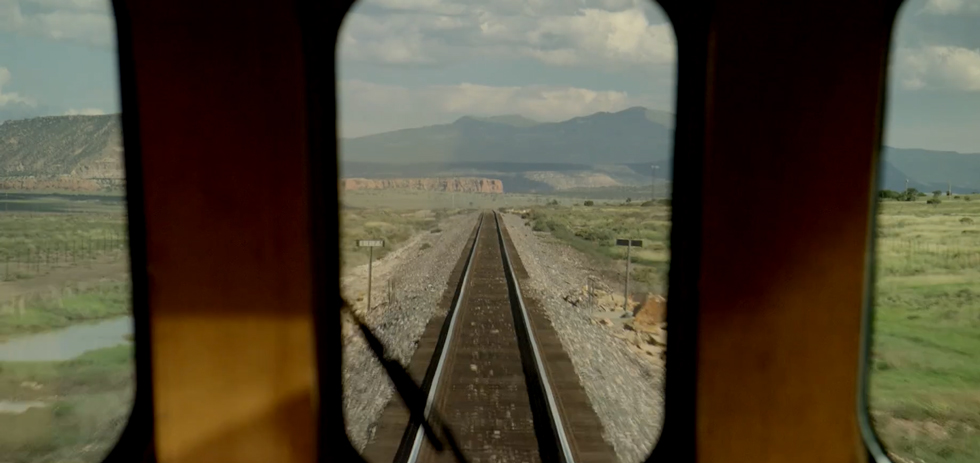
It’s hard to define exactly what Station to Station is but perhaps easier to work out what it is not. It’s not a music documentary, as its programming in the Sounds on Screen section of the Sydney Film Festival would suggest. It’s not a series of short films, despite being divided up into 62 one-minute vignettes. It’s not an examination of the role trains play in our lives, or really any salient statement on traversing America by rail. Doug Aitken’s film, then, is something other than atypical, pigeonholing it as a celebration of music or art doesn’t cut it either. The closest I can come up with is that Station to Station is a curated art exhibition stuck in amber and in itself a piece of collage cinema that interweaves concert footage, sculpture, poetry recital, interviews and other experimental elements to capture a free-floating ethos of artistic creation.
It’s not as if the film doesn’t attempt to define itself, though. In the first vignette of the film, titled “This is a Happening”, we’re given what amounts to a sampler of the next hour, snippets of wildly different images are intercut with Aitken himself explaining to a camera (though not our camera), what Station to Station is about. “This is not a tour, this is not a package, it’s not a system, it’s something that is ever-changing” he says, though he’s less talking about the film Station to Station than the art project of the same name, which the film amounts to an bizarre diary of. Station to Station, the art project, was centred around a 23-day train journey from the Atlantic to the Pacific that feature ten ‘Happenings’, which amount to a hybrid art exhibition and concert.1 The artists and musicians participating float in and out of the film and project, collaborating on-stage and on the train in seemingly spontaneous performances and to the fulfillment of an array of artistic ideas. Journalists on board, whose pieces about the art collective made their way to print months before the film premiered, are presumably there to decipher and promote, though no one’s entirely sure what to say, as seen in this mammoth Wired Magazine article and a piece by Sasha Frere-Jones at the New Yorker (he also appears on-screen).2
Even the train itself is a work of art. Aitken, an artist who made his name with video and outdoor film installations, designed the lights and scheme of reaction to motion that coat the exterior of the vintage train, the piece entitled “Nomadic Light Sculpture”. Many of the most arresting elements in the film are pieces relying entirely on the train itself, making the experience of the film far different from that of an attendee at one of the Happenings. Olafur Eliasson’s Kinetic Drawing Machine sees a small ball coated in black ink roll around a piece of paper on a drum-like surface, mapping out the movement of the train abstractly. Christian Jankowski’s hilarious “How’s My Driving” sees a massive sticker baring that message placed at the end of the train. One of the more engaging film-based vignettes comes in about a third of the way through, entitled “Snapshots”, which is just a Benning-esque sequence of shots looking out of the train windows, showcasing not only a shifting landscape but a wonderful harmonious collaboration between Aitken, co-cinematographer Corey Walter and editor Austin Meredith.
As expected, the film is also interested in the performative space, though this has some drawbacks as the film is far better at capturing artists and performers than the crowd who pay to see them. Perhaps the only successful engagement with crowds in the concert-based vignettes are those featuring Dan Deacon, who uses his audience as both instrument and visual tool. This paring back of audience engagement does tend to fall in line with a thematic throughline in the film, that being that artists reject the normalcy of the everyman, something conceptual artist Lawrence Weiner expounds upon at one point. Elmer Long, an artist who works with empty bottles, puts it a bit more holistically – “I do what I want to do…I never thought of it as art, I thought of it as freedom.”
The rhythm of the film does take some getting used to, as each of the short vignettes have no distinct structure to them for the most part, shifting between each is sudden and disorienting, though that’s all part of the kaleidoscopic effect, as each cut seems to underline the fleeting nature of artistic experience. It’s not a short-changing the viewer though; whilst the film’s runtime is relatively brief it is packed with interesting images, sound and editing. Since people spend, on average, 30 seconds looking at an artwork in a museum, it’s generous for Aitken and co. give us double that.
Around the Staff
| Jeremy Elphick | |
| Brad Mariano |
